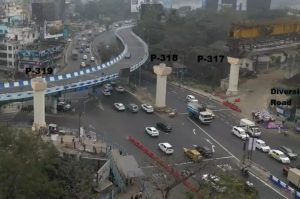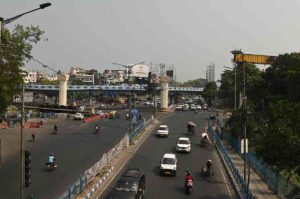Kolkata Police Approve Night Traffic Blocks: The bustling city of Kolkata is set for another round of infrastructural reshaping as the police have granted long-awaited approval for night-time traffic blocks at Chingrighata, one of the city’s most congested intersections. Scheduled for November 14–16 and 21–23, 2025, these planned traffic diversions will pave the way for the Rail Vikas Nigam Ltd (RVNL) to execute critical girder launching for the Orange Line of the Kolkata Metro.
For thousands of daily commuters, this announcement represents both relief and apprehension. Relief, because it signals progress in a project that has been stalled for months. Apprehension, because temporary closures at Chingrighata — a junction where traffic from Salt Lake, Sector V, New Town, and VIP Road meets — almost always translate into bottlenecks across the city.
A Junction That Holds the City Hostage
Chingrighata is not just another traffic signal. It is the lifeline where Eastern Metropolitan Bypass (EM Bypass) intersects with the Salt Lake connector, linking Kolkata’s IT hub of Sector V with the southern neighborhoods. For years, commuters have dubbed it the city’s “perennial choke point.”
On a typical evening, vehicles stretch in long queues from Nicco Park to the Bypass flyover, with buses, motorcycles, and trucks fighting for lanes. Add in jaywalking pedestrians and the absence of seamless flyovers, and the chaos often spirals into gridlock.
The pending viaduct construction for the Orange Line has only aggravated matters. While most of the Ruby-to-Sector V metro corridor stands complete, the last 366-meter stretch at Chingrighata remained unfinished due to police hesitation in permitting traffic blocks.
Judicial Push: Court Steps In
The deadlock reached such proportions that the Calcutta High Court intervened earlier this year. A public interest litigation (PIL) was filed highlighting the delay’s impact on public convenience, economic efficiency, and safety.
In a rather unique move, the High Court convened a meeting over tea with all stakeholders — Kolkata Police, KMDA, RVNL, and Metro Railway. The informal setting was aimed at fostering cooperation rather than confrontation. The court’s message was clear: the city cannot afford delays in projects of this magnitude.
This judicial nudge accelerated consensus, leading to the police’s eventual nod for limited night-time closures.
Kolkata Police Approve Night Traffic Blocks: Preparations for the Diversion
Before the November traffic blocks, RVNL completed work on a western diversion road. This stretch will now temporarily absorb traffic flows while girder-lifting operations are conducted overhead. Signals, red beacons, barricades, and signage are being put in place to guide drivers during the diversions.

The police plan to reroute heavy vehicles via Majherpara and Canal Road, while maintaining limited access for emergency and essential services. Traffic trials have been scheduled to iron out issues before full-scale closure.
Why This Metro Link Matters
The Orange Line — also known as the East-West Metro’s Airport-New Garia stretch — is more than a transportation project. It represents:
- Connectivity to IT Sector: Linking southern Kolkata to Sector V and New Town, easing commutes for thousands of tech employees.
- Airport Integration: Seamless travel from the southern suburbs to the airport, reducing dependency on congested surface routes.
- Economic Impact: Faster travel means fewer delays for businesses and improved productivity across the city.
- Environmental Gains: Fewer cars on the road translate into reduced emissions in one of India’s most polluted metros.
Completion of the Chingrighata stretch is the final piece of the puzzle. Once girders are installed and the viaduct completed, the metro line can run trial services into Sector V — a milestone Kolkata commuters have awaited for over a decade.
Public Reaction: Between Hope and Frustration
The public mood reflects cautious optimism. While commuters welcome progress, many voice concerns about whether diversions will truly hold up against real traffic volumes.
- A daily commuter from New Town said: “Every evening I lose 45 minutes at Chingrighata. If this closure means metro relief in the long run, I’m ready to bear a few nights of chaos.”
- Another IT employee remarked: “The metro project has been delayed too much. If police and RVNL had acted earlier, we wouldn’t have reached this point.”
On platforms like Reddit and local Facebook groups, users debated potential alternatives — from flyover construction to bus stop relocations — showing how deeply the issue resonates with residents.
Pedestrian Concerns
Beyond vehicle congestion, Chingrighata has a history of pedestrian safety challenges. Studies suggest that nearly 35% of pedestrian accidents along the EM Bypass corridor are linked to jaywalking at this junction.
To address this, plans are underway for:
- A Rs 20 crore three-way pedestrian subway under the crossing, jointly funded by KMDA and RVNL.
- Steel barricades beneath flyovers and near bus stops to channel foot traffic safely.
These measures, once completed, aim to make Chingrighata safer not just for drivers but also for the thousands of people who cross it daily on foot.
Timeline of Events
| Year/Month | Development |
|---|---|
| Early 2025 | Diversion road construction by RVNL completed. |
| Mid-2025 | Project stalled as police withheld permission for traffic block. |
| Aug 2025 | PIL filed in Calcutta High Court, urging resolution. |
| Sept 2025 | High Court convenes meeting with stakeholders. |
| Nov 2025 | Police approve night-time closures on 14–16 and 21–23. |
| Expected | Girder launching and viaduct completion by end of November. |
The Larger Urban Picture
Kolkata’s struggles at Chingrighata mirror wider urban planning challenges in India’s megacities:
- Overlapping Authorities: Projects often stall due to coordination failures among municipal bodies, police, and central agencies.
- Public Patience: Citizens face recurring inconvenience without clarity on timelines.
- Legal Recourse: Increasingly, courts are stepping in to accelerate stalled civic works.
Urban planners argue that such bottlenecks could be prevented through better foresight and integrated planning. Cities like Delhi and Bengaluru, despite facing their own challenges, have demonstrated how pre-planned traffic diversions and flyovers can reduce conflicts during major projects.
What Lies Ahead
If operations go smoothly during the November closures, the metro authorities are expected to announce trial runs into Gour Kishore Ghosh Metro Station by early 2026. This would connect southern Kolkata with Sector V and bring the dream of airport integration within tangible reach.


The eventual completion could reframe how people live and work in Kolkata — reducing dependency on cars, cutting commuting time, and providing a world-class rapid transit alternative.
Final Thoughts
The decision to allow traffic blocks at Chingrighata is more than a police order; it symbolizes a breakthrough in bureaucratic gridlock that often paralyses urban infrastructure. For Kolkata, this is a litmus test in balancing commuter inconvenience with long-term progress.
If executed well, November’s closures could go down as a turning point in the city’s metro revolution, turning Chingrighata from a symbol of congestion into one of connection.
🔗 External References for Context:
- Kolkata Metro Orange Line Project Overview – Wikipedia
- Urban Transport Infrastructure in India – World Bank
- Road Safety in Indian Cities – Ministry of Road Transport and Highways
Also read: Home | Channel 6 Network – Latest News, Breaking Updates: Politics, Business, Tech & More

